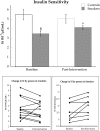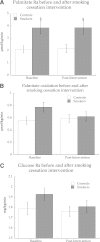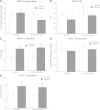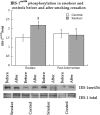Novel and reversible mechanisms of smoking-induced insulin resistance in humans
- PMID: 22966072
- PMCID: PMC3501865
- DOI: 10.2337/db12-0418
Novel and reversible mechanisms of smoking-induced insulin resistance in humans
Abstract
Smoking is the most common cause of preventable morbidity and mortality in the United States, in part because it is an independent risk factor for the development of insulin resistance and type 2 diabetes. However, mechanisms responsible for smoking-induced insulin resistance are unclear. In this study, we found smokers were less insulin sensitive compared with controls, which increased after either 1 or 2 weeks of smoking cessation. Improvements in insulin sensitivity after smoking cessation occurred with normalization of IRS-1(ser636) phosphorylation. In muscle cell culture, nicotine exposure significantly increased IRS-1(ser636) phosphorylation and decreased insulin sensitivity, recapitulating the phenotype of smoking-induced insulin resistance in humans. The two pathways known to stimulate IRS-1(ser636) phosphorylation (p44/42 mitogen-activated protein kinase [MAPK] and mammalian target of rapamycin [mTOR]) were both stimulated by nicotine in culture. Inhibition of mTOR, but not p44/42 MAPK, during nicotine exposure prevented IRS-1(ser636) phosphorylation and normalized insulin sensitivity. These data indicate nicotine induces insulin resistance in skeletal muscle by activating mTOR. Therapeutic agents designed to oppose skeletal muscle mTOR activation may prevent insulin resistance in humans who are unable to stop smoking or are chronically exposed to secondhand smoke.
Figures








Comment in
-
Nicotine and insulin resistance: when the smoke clears.Diabetes. 2012 Dec;61(12):3078-80. doi: 10.2337/db12-1100. Diabetes. 2012. PMID: 23172960 Free PMC article. No abstract available.
Similar articles
-
mTOR partly mediates insulin resistance by phosphorylation of insulin receptor substrate-1 on serine(307) residues after burn.Burns. 2011 Feb;37(1):86-93. doi: 10.1016/j.burns.2010.04.005. Epub 2010 Jul 1. Burns. 2011. PMID: 20594757
-
Increased activation of the mammalian target of rapamycin pathway in liver and skeletal muscle of obese rats: possible involvement in obesity-linked insulin resistance.Endocrinology. 2005 Mar;146(3):1473-81. doi: 10.1210/en.2004-0921. Epub 2004 Dec 16. Endocrinology. 2005. PMID: 15604215
-
Enhanced skeletal muscle insulin sensitivity after acute resistance-type exercise is upregulated by rapamycin-sensitive mTOR complex 1 inhibition.Sci Rep. 2020 May 22;10(1):8509. doi: 10.1038/s41598-020-65397-z. Sci Rep. 2020. PMID: 32444657 Free PMC article.
-
Regulation of insulin sensitivity by serine/threonine phosphorylation of insulin receptor substrate proteins IRS1 and IRS2.Diabetologia. 2012 Oct;55(10):2565-2582. doi: 10.1007/s00125-012-2644-8. Epub 2012 Aug 8. Diabetologia. 2012. PMID: 22869320 Free PMC article. Review.
-
TOR-centric view on insulin resistance and diabetic complications: perspective for endocrinologists and gerontologists.Cell Death Dis. 2013 Dec 12;4(12):e964. doi: 10.1038/cddis.2013.506. Cell Death Dis. 2013. PMID: 24336084 Free PMC article. Review.
Cited by
-
Effects of Smoking on the Gut Microbiota in Individuals with Type 2 Diabetes Mellitus.Nutrients. 2022 Nov 13;14(22):4800. doi: 10.3390/nu14224800. Nutrients. 2022. PMID: 36432487 Free PMC article.
-
Insulin resistance by the triglyceride-glucose index in a rural Brazilian population.Arch Endocrinol Metab. 2022 Nov 17;66(6):848-855. doi: 10.20945/2359-3997000000509. Epub 2022 Aug 4. Arch Endocrinol Metab. 2022. PMID: 35929905 Free PMC article.
-
Smoking and cardiovascular disease in patients with type 2 diabetes: a prospective observational study.J Cardiovasc Med (Hagerstown). 2023 Nov 1;24(11):802-807. doi: 10.2459/JCM.0000000000001540. Epub 2023 Sep 27. J Cardiovasc Med (Hagerstown). 2023. PMID: 37768866 Free PMC article.
-
Relationship between urinary iodine concentration and all-cause mortality in individuals with diabetes: An analysis of National Health and Nutrition Examination Survey 2005 - 2018.Hormones (Athens). 2025 Apr 12. doi: 10.1007/s42000-025-00653-3. Online ahead of print. Hormones (Athens). 2025. PMID: 40216670
-
Metabolic syndrome: a population-based study of prevalence and risk factors.Sci Rep. 2024 Feb 17;14(1):3987. doi: 10.1038/s41598-024-54367-4. Sci Rep. 2024. PMID: 38368464 Free PMC article.
References
-
- Centers for Disease Control and Prevention (CDC) Cigarette smoking among adults—United States, 2007. MMWR Morb Mortal Wkly Rep 2008;57:1221–1226 - PubMed
-
- Schroeder SA, Warner KE. Don’t forget tobacco. N Engl J Med 2010;363:201–204 - PubMed
-
- Kannel WB, D’Agostino RB, Belanger AJ. Fibrinogen, cigarette smoking, and risk of cardiovascular disease: insights from the Framingham Study. Am Heart J 1987;113:1006–1010 - PubMed
-
- Feskens EJ, Kromhout D. Cardiovascular risk factors and the 25-year incidence of diabetes mellitus in middle-aged men. The Zutphen Study. Am J Epidemiol 1989;130:1101–1108 - PubMed
Publication types
MeSH terms
Substances
Grants and funding
LinkOut - more resources
Full Text Sources
Medical
Molecular Biology Databases
Miscellaneous

